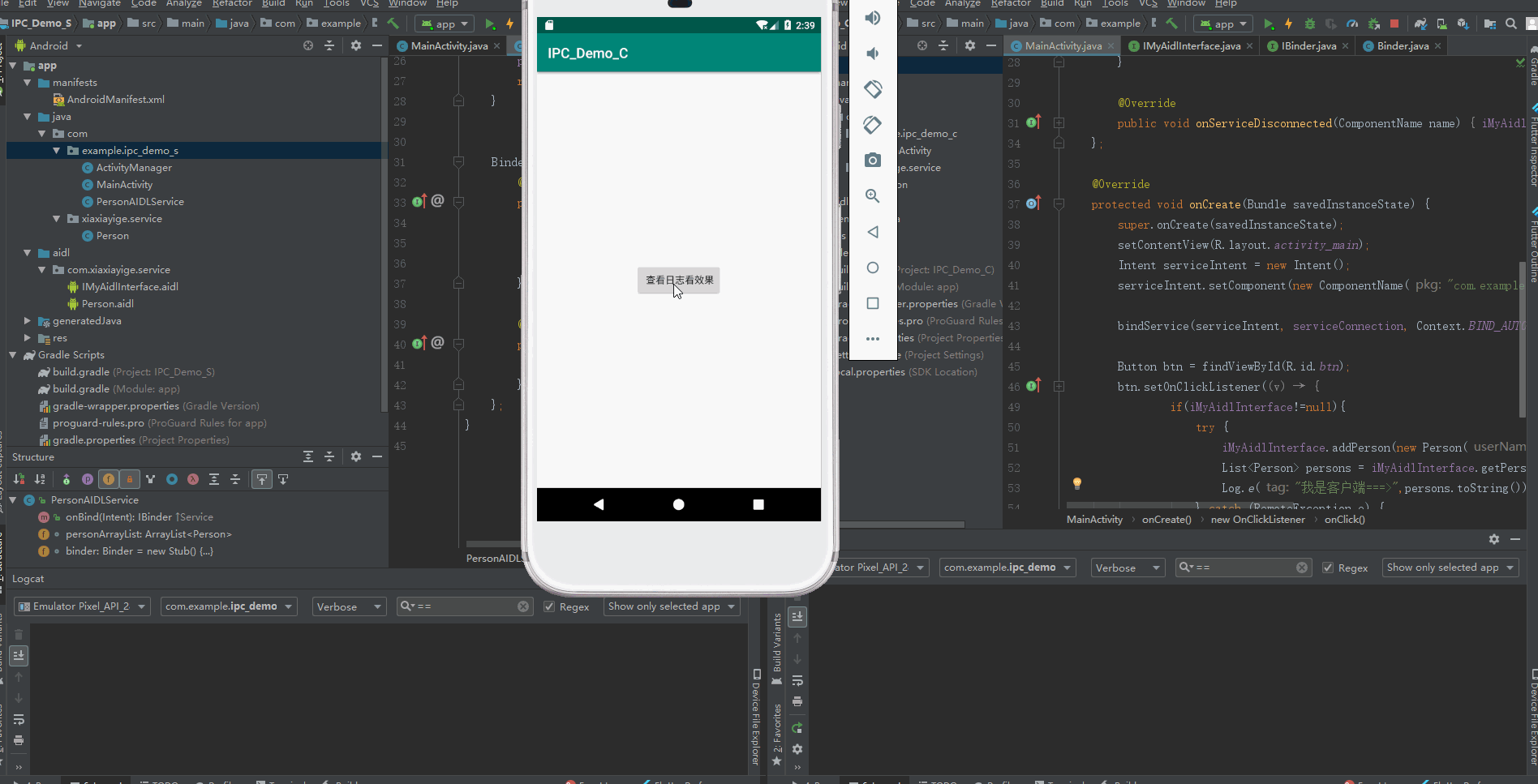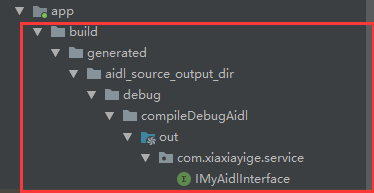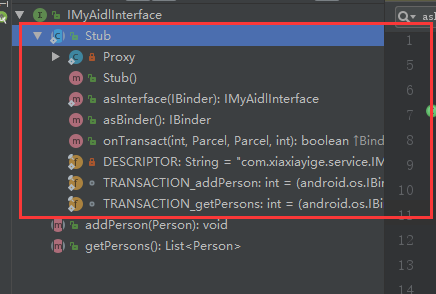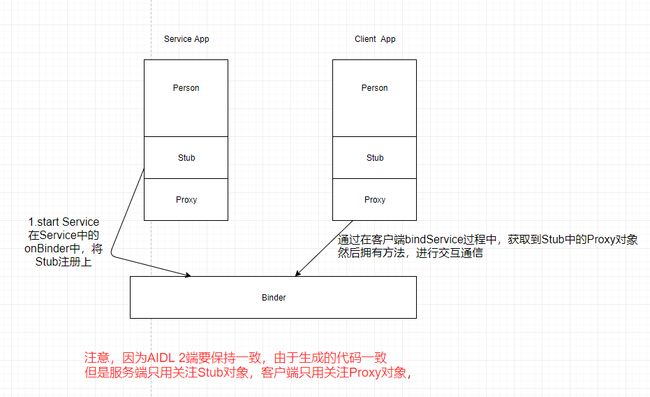Android学习笔记------进程间通信AIDL学习和深入理解
想要直接看效果的可以直接去看 #5.4
想要源代码的可以直接去末尾
1.AIDL(Android 接口定义语言)是什么?
官网说明:https://developer.android.com/guide/components/aidl
简单来说就是让处于不同进程间的数据可以交互,可以通信。比如A,B2个独立的App,A的数据可以告诉B,B的数据可以告诉A。
2.常见的几种进程间通信有哪些?
1.管道(Socket) (传输效率低,开销大,主要用于跨网络的进程间通信和本机上进程间的低速通信)
2.Messager(消息队列,采用存储-转发的方式,先把数据从发送方拷贝到内核,开辟的缓存中,
然后再从内核缓存中拷贝到接受方的内存缓存区,至少有2次拷贝过程)
3.共享内存(虽然无需拷贝,操作复杂,难以使用)
4.Binder (只需要一次数据拷贝,性能上仅次于内存共享)
3.AIDL和IPC是什么关系?
AIDL只是我们去实现IPC进程间通信的一种实现方式
4.学习之前要知道哪些内容
1.客户端,服务端
2.bindService
3.Parcelable
5.开始学习
以下都是Demo实现。
1.场景重现:
假设我们这里有一个Service App和Client App 这2个App,大家都有共同的一个Person对象,Client App 里面有一个注册入口,
注册的Person我们需要发送给Service App保存记录(这个时候排除掉上传服务器等其他操作哈,嘻嘻,以下简称S 和 C App)。
5.1 首先定义AIDL接口
1.首先我们要一个Person类, 因为S 和 C 都是需要的。并且应该以S App为准。
所以 S创建好了Person类以后,C App只需要拷贝就行了。
2.类对象创建好了以后,要实现Parcelable接口 (Android Studio 有对应的插件,不会写的直接插件生成就好啦,
哈哈,因为我也不会,写太麻烦啦。)
3.定义AIDL接口:
3.1 首先分析我们需要做什么操作?
首先有一个AddPerson的方法,把Person添加到S App中,然后我们在提供一个getPersons方法,
这样添加完以后我们再获取一下所有的Person。那么我们看实现的代码和AIDL代码是怎样
以下操作都是在S app中进行的
1.首先是Person类(就是一个实体类,不用太在意):
package com.xiaxiayige.service;
import android.os.Parcel;
import android.os.Parcelable;
public class Person implements Parcelable {
private String userName;
private int age;
public Person(String userName, int age) {
this.userName = userName;
this.age = age;
}
@Override
public int describeContents() {
return 0;
}
@Override
public void writeToParcel(Parcel dest, int flags) {
dest.writeString(this.userName);
dest.writeInt(this.age);
}
protected Person(Parcel in) {
this.userName = in.readString();
this.age = in.readInt();
}
public static final Creator CREATOR = new Creator() {
@Override
public Person createFromParcel(Parcel source) {
return new Person(source);
}
@Override
public Person[] newArray(int size) {
return new Person[size];
}
};
@Override
public String toString() {
return "Person{" +
"userName='" + userName + '\'' +
", age=" + age +
'}';
}
}
2.创建定义的AIDL文件
1.首先创建一个Person.AIDL的文件
// Person.aidl
package com.xiaxiayige.service;
parcelable Person;
2.然后定义传输方法
// IMyAidlInterface.aidl
package com.xiaxiayige.service;
//导入Person包 如果是其他基本类型则不需要导入
import com.xiaxiayige.service.Person;
interface IMyAidlInterface {
//定义一个AddPerson的方法 这里方法中有一个in 参数 表示传入的,如果是其他基本类型则不需要in参数
void addPerson(in Person person);
//添加一个getPersons的方法获取Person
List getPersons();
}
3.然后将上面的类和AIDL拷贝到C App,保持包名和S App中的完全一致。这样才能找到对应的方法和数据类型
5.2 完成Service App编码
上面我们已经完成了在Service的一些基本操作,包括Person对象的创建,AIDL文件的创建,接下来我们需要完成其他方法。
1.首先我们要有一个Service,并且重写onBinder方法
public class PersonAIDLService extends Service {
//创建一个list,保存从client App进来的Person对象
ArrayList personArrayList;
@Override
public IBinder onBind(Intent intent) {
personArrayList = new ArrayList<>();
return binder;
}
//IMyAidlInterface 这个类后面会讲到,定义了AIDL后会自动生成这样一个类供我们调用
//这里我们先通过new IMyAidlInterface的Stub内部类创建一个Binder对象,
//后面我们在去分析生成的IMyAidlInterface类做了什么
Binder binder = new IMyAidlInterface.Stub() {
@Override
public void addPerson(Person person) throws RemoteException {
Log.e("<===", person.toString());
personArrayList.add(person);
}
@Override
public List getPersons() throws RemoteException {
return personArrayList;
}
};
}
2.有了Service,我们就直接去MainActivity中startService
Intent serviceIntent = new Intent(this, PersonAIDLService.class);
startService(serviceIntent);
3.别忘记在Manifest文件中注册一下
5.3 完成Client App编码
1.上面我们已经完成了Person.java Person.aidl, IMyAidlInterface.aidl几个文件的创建,
然后拷贝到Client App,保持和App包名信息一致即可
2.然后我们在Client App中绑定S App中创建的Service
public class MainActivity extends AppCompatActivity {
//AIDL自动生成的IMyAidlInterface类文件
private IMyAidlInterface iMyAidlInterface;
ServiceConnection serviceConnection = new ServiceConnection() {
@Override
public void onServiceConnected(ComponentName name, IBinder service) {
iMyAidlInterface = IMyAidlInterface.Stub.asInterface(service);
}
@Override
public void onServiceDisconnected(ComponentName name) {
iMyAidlInterface = null;
}
};
@Override
protected void onCreate(Bundle savedInstanceState) {
super.onCreate(savedInstanceState);
setContentView(R.layout.activity_main);
Intent serviceIntent = new Intent();
//绑定启动Service 通过制定S app中的包名和具体的包名+类名全路径
serviceIntent.setComponent(new ComponentName("com.example.ipc_demo_s",
"com.example.ipc_demo_s.PersonAIDLService"));
bindService(serviceIntent, serviceConnection, Context.BIND_AUTO_CREATE);
Button btn = findViewById(R.id.btn);
btn.setOnClickListener(new View.OnClickListener() {
@Override
public void onClick(View v) {
if(iMyAidlInterface!=null){
try {
//通过按钮调用Person方法,添加数据
iMyAidlInterface.addPerson(new Person("xiaxiayige",18));
//调用AIDL里面的getPerson方法获取Person数据
List persons = iMyAidlInterface.getPersons();
//日志数据打印
Log.e("===>",persons.toString());
} catch (RemoteException e) {
e.printStackTrace();
}
}
}
});
}
}
终于,写了这么久,先看看效果吧我们再去分析下生成的代码里面做了什么操作。
5.4 成果展示
通过上面的代码编写,我们最后的效果 如下所示
连接如果看不到,看不清效果的就点击连接看吧 https://raw.githubusercontent.com/xiaxiayige/LearingProJect/master/img/aidl_a.gif),可以看见打印的时间基本上是同一时间打印出来的。
6.0 AIDL深入理解
6.1 AIDL分析
1.通过我们上面编写的AIDl代码,我们来看看生成的对应的java代码是什么样的。
代码文件路径在下图的地方:
然后打开看看里面的代码具体分析。
`public interface IMyAidlInterface extends android.os.IInterface {
/**
* Local-side IPC implementation stub class.
*/
public static abstract class Stub extends android.os.Binder implements com.xiaxiayige.service.IMyAidlInterface {
private static final java.lang.String DESCRIPTOR = "com.xiaxiayige.service.IMyAidlInterface";
/**
* Construct the stub at attach it to the interface.
*
*/
public Stub() {
this.attachInterface(this, DESCRIPTOR);
}
/**
* Cast an IBinder object into an com.xiaxiayige.service.IMyAidlInterface interface,
* generating a proxy if needed.
*/
public static com.xiaxiayige.service.IMyAidlInterface asInterface(android.os.IBinder obj) {
if ((obj == null)) {
return null;
}
android.os.IInterface iin = obj.queryLocalInterface(DESCRIPTOR);
if (((iin != null) && (iin instanceof com.xiaxiayige.service.IMyAidlInterface))) {
return ((com.xiaxiayige.service.IMyAidlInterface) iin);
}
return new com.xiaxiayige.service.IMyAidlInterface.Stub.Proxy(obj);
}
@Override
public android.os.IBinder asBinder() {
return this;
}
@Override
public boolean onTransact(int code, android.os.Parcel data, android.os.Parcel reply, int flags) throws android.os.RemoteException {
java.lang.String descriptor = DESCRIPTOR;
switch (code) {
case INTERFACE_TRANSACTION: {
reply.writeString(descriptor);
return true;
}
case TRANSACTION_addPerson: {
data.enforceInterface(descriptor);
com.xiaxiayige.service.Person _arg0;
if ((0 != data.readInt())) {
_arg0 = com.xiaxiayige.service.Person.CREATOR.createFromParcel(data);
} else {
_arg0 = null;
}
this.addPerson(_arg0);
reply.writeNoException();
return true;
}
case TRANSACTION_getPersons: {
data.enforceInterface(descriptor);
java.util.List _result = this.getPersons();
reply.writeNoException();
reply.writeTypedList(_result);
return true;
}
default: {
return super.onTransact(code, data, reply, flags);
}
}
}
private static class Proxy implements com.xiaxiayige.service.IMyAidlInterface {
private android.os.IBinder mRemote;
Proxy(android.os.IBinder remote) {
mRemote = remote;
}
@Override
public android.os.IBinder asBinder() {
return mRemote;
}
public java.lang.String getInterfaceDescriptor() {
return DESCRIPTOR;
}
@Override
public void addPerson(com.xiaxiayige.service.Person person) throws android.os.RemoteException {
android.os.Parcel _data = android.os.Parcel.obtain();
android.os.Parcel _reply = android.os.Parcel.obtain();
try {
_data.writeInterfaceToken(DESCRIPTOR);
if ((person != null)) {
_data.writeInt(1);
person.writeToParcel(_data, 0);
} else {
_data.writeInt(0);
}
mRemote.transact(Stub.TRANSACTION_addPerson, _data, _reply, 0);
_reply.readException();
} finally {
_reply.recycle();
_data.recycle();
}
}
@Override
public java.util.List getPersons() throws android.os.RemoteException {
android.os.Parcel _data = android.os.Parcel.obtain();
android.os.Parcel _reply = android.os.Parcel.obtain();
java.util.List _result;
try {
_data.writeInterfaceToken(DESCRIPTOR);
mRemote.transact(Stub.TRANSACTION_getPersons, _data, _reply, 0);
_reply.readException();
_result = _reply.createTypedArrayList(com.xiaxiayige.service.Person.CREATOR);
} finally {
_reply.recycle();
_data.recycle();
}
return _result;
}
}
static final int TRANSACTION_addPerson = (android.os.IBinder.FIRST_CALL_TRANSACTION + 0);
static final int TRANSACTION_getPersons = (android.os.IBinder.FIRST_CALL_TRANSACTION + 1);
}
public void addPerson(com.xiaxiayige.service.Person person) throws android.os.RemoteException;
public java.util.List getPersons() throws android.os.RemoteException;
}`
6.1.1 Stub
1.首先我们创建的AIDL文件为我们自动生成了IMyAidlInterface这样一个类文件,并且继承了 IMyAidlInterface接口。 可以看一下这个类源码文件
·
IInterface.java
/**
* Base class for Binder interfaces. When defining a new interface,
* you must derive it from IInterface.
*/
public interface IInterface
{
/**
* Retrieve the Binder object associated with this interface.
* You must use this instead of a plain cast, so that proxy objects
* can return the correct result.
*/
public IBinder asBinder();
}
从上面的文件可以看出来,这是一个Binder基础类接口,继承了该类的文件,基本上都是用到了Binder机制。继承该类以后实现自己的Binder在As Binder中返回。
- 里面创建了一个Stub内部抽象类,然后通过我们的AIDL中定义的方法,也生成了对应的addPerson 方法和getPerson方法。
3.然后在看看Stub类有些什么东西
可以看到Stub类里面有一个内部类Proxy,还有其他几个方法,包括asBinder,返回是一个IBinder对象,就是我们实现了IInterface类里面的一个方法,我们从上往下看看,都是做了些什么操作。
1 声明了一个静态常量 表示这个AIDL的唯一性,全路径名称
private static final java.lang.String DESCRIPTOR = "com.xiaxiayige.service.IMyAidlInterface";
.
2.构造方法,当Service App中的Service启动的时候。因为我们在Service中的onBinder方法中创建了了这个Stub类
因为他也是属于一个Binder,所以在Service中的onBinder方法返回了这个Binder,将Binder绑定到了这个Service中
,所以在Client App中可以通过调用这个Service中的Binder进行通信交互
public Stub() {
this.attachInterface(this, DESCRIPTOR);
}
.
3.看注释吧
public static com.xiaxiayige.service.IMyAidlInterface asInterface(android.os.IBinder obj) {
//判断出入的对象是否为空
if ((obj == null)) {
return null;
}
//检查这个Binder是否在本地进程中存在(因为有可能已经存在同样的Binder),如果存在则直接返回
android.os.IInterface iin = obj.queryLocalInterface(DESCRIPTOR);
if (((iin != null) && (iin instanceof com.xiaxiayige.service.IMyAidlInterface))) {
return ((com.xiaxiayige.service.IMyAidlInterface) iin);
}
//如果本地没有查询到 则创建一个Proxy类返回
return new com.xiaxiayige.service.IMyAidlInterface.Stub.Proxy(obj);
}
4.返回当前Binder
@Override
public android.os.IBinder asBinder() {
return this;
}
5.根据在AIDL文件中定义的2个方法,在生成类文件里面也自动生成了对应的关系,
可以看见变量名称就是TRANSACTION加上我们定义的方法名,值就是通过系统的值
android.os.IBinder.FIRST_CALL_TRANSACTION 加上 一个顺序的值 从0开始,这样做的原因是
因为服务端和客户端2遍生成的代码因为是一致的,这样客户端调用服务端方法的时候,就能根据这样的变量值,找到对应要执行的代码
static final int TRANSACTION_addPerson = (android.os.IBinder.FIRST_CALL_TRANSACTION + 0);
static final int TRANSACTION_getPersons = (android.os.IBinder.FIRST_CALL_TRANSACTION + 1);
5.这个方法主要是用于Client App端调用方法的具体实现。关于switch语句中的几个常量值上面已经提过了
@Override
public boolean onTransact(int code, android.os.Parcel data, android.os.Parcel reply, int flags) throws android.os.RemoteException {
java.lang.String descriptor = DESCRIPTOR;
switch (code) {
case INTERFACE_TRANSACTION: {
reply.writeString(descriptor);
return true;
}
case TRANSACTION_addPerson: {
data.enforceInterface(descriptor);
com.xiaxiayige.service.Person _arg0;
if ((0 != data.readInt())) {
_arg0 = com.xiaxiayige.service.Person.CREATOR.createFromParcel(data);
} else {
_arg0 = null;
}
//调用我们的方法
this.addPerson(_arg0);
//告诉没有异常
reply.writeNoException();
return true;
}
case TRANSACTION_getPersons: {
data.enforceInterface(descriptor);
//调用我们的方法
java.util.List _result = this.getPersons();
//告诉没有异常
reply.writeNoException();
reply.writeTypedList(_result);
return true;
}
default: {
return super.onTransact(code, data, reply, flags);
}
}
}
6.1.2 Proxy
主要看注释吧
private static class Proxy implements com.xiaxiayige.service.IMyAidlInterface {
private android.os.IBinder mRemote;
//这里传入了Stub类的实例 ,可以看到在上面Stub asInterface的时候 传入了一个Binder对象 因为这个主要是在
Client中调用的,所以传入的就是Service App 中的 Binder对象 也就是Stub这个实例
Proxy(android.os.IBinder remote) {
mRemote = remote;
}
@Override
public android.os.IBinder asBinder() {
return mRemote;
}
public java.lang.String getInterfaceDescriptor() {
return DESCRIPTOR;
}
//这就是具体实现的方法在Client调用的
@Override
public void addPerson(com.xiaxiayige.service.Person person) throws android.os.RemoteException {
android.os.Parcel _data = android.os.Parcel.obtain();
android.os.Parcel _reply = android.os.Parcel.obtain();
try {
_data.writeInterfaceToken(DESCRIPTOR);
if ((person != null)) {
_data.writeInt(1);
person.writeToParcel(_data, 0);
} else {
_data.writeInt(0);
}
//调用服务端的transact方法 具体实现
mRemote.transact(Stub.TRANSACTION_addPerson, _data, _reply, 0);
_reply.readException();
} finally {
_reply.recycle();
_data.recycle();
}
}
@Override
public java.util.List getPersons() throws android.os.RemoteException {
android.os.Parcel _data = android.os.Parcel.obtain();
android.os.Parcel _reply = android.os.Parcel.obtain();
java.util.List _result;
try {
_data.writeInterfaceToken(DESCRIPTOR);
//调用服务端的transact方法 具体实现
mRemote.transact(Stub.TRANSACTION_getPersons, _data, _reply, 0);
_reply.readException();
_result = _reply.createTypedArrayList(com.xiaxiayige.service.Person.CREATOR);
} finally {
_reply.recycle();
_data.recycle();
}
return _result;
}
}
6.2.0 综合总结
AIDL是需要启动一个Service作为绑定连接的,并且Service要运行其他进程可访问就是在配置的时候要记得添加
android:exported="true" 这样一个属性。
7.结尾
所以呢,这就是我自己的一个学习理解过程,当中可能也有自己理解错的地方,大家可以指出我也好学习学习 ,哈哈。
其实有其他很多的我们平时没有关注到的一些用到的服务也是用得AIDL,大家可以去看看,包括ActivityManagerService,再往深入了解就是需要了解内部Binder的原理。等到下次再来接着这边文章分析吧
8.Demo地址
Github:https://github.com/xiaxiayige/LearingProJect/tree/master/AIDLDemo
9. 遗留问题
如果service App没有打开,那么Client App 还能不能调用到Service App中的方法,通过AIDL? 这是为什么?




